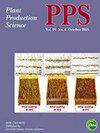外源独角麦内酯对组培生姜生长、干物质积累和产量的影响
IF 1.3
3区 农林科学
Q2 AGRONOMY
引用次数: 0
摘要
摘要生姜组织培养苗可以降低土传病害的发生率。然而,它们有几个枝条,小的姜球茎,种子恢复缓慢。Strigolactone可以抑制侧芽的生长,调整植物类型,提高作物产量。本研究采用外源己果内酯处理组织培养的生姜,并评价其对生长、干物质积累和产量的影响。结果表明,随着外源GR24(strigolactone的合成类似物,rac-GR24)的施用,单株生姜的枝条和鳞茎数量显著减少,并且浓度越高,减少的幅度越大。株高、茎径、根、根茎、茎鞘、叶和植株干物质积累、平均姜球重和产量均显著增加,随浓度的增加先增加后减少。根据浓度的不同,外源己果内酯可以抑制组织培养生姜的分枝,减少分枝数量,增加株高和茎径,优化地上植物类型,增加干物质积累和根冠比,减少单株生姜鳞茎数量,增加平均姜球重,提高产量。当GR24浓度进一步增加时,分枝数、株高、茎粗、干物质积累、根冠比、单株姜鳞茎、姜鳞茎平均重量和姜产量都有所下降。用7.5μm L−1的外源GR24处理可以优化组织培养生姜的株型并提高产量。图形摘要本文章由计算机程序翻译,如有差异,请以英文原文为准。
Effects of exogenous strigolactone on growth, dry matter accumulation, and yield of tissue-cultured ginger
ABSTRACT Ginger tissue culture seedlings can reduce the incidence of soil-borne diseases. However, they have several branches, small ginger bulbs, and slow seed recovery. Strigolactone can inhibit the growth of lateral buds, adjust plant types, and increase crop yield. This study used exogenous strigolactone to treat tissue-cultured ginger and assess its effects on growth, dry matter accumulation, and yield. The results showed that the number of branches and ginger bulbs per plant decreased significantly with the application of exogenous GR24 (Synthetic analog of strigolactone, rac-GR24), and higher concentrations led to a greater decrease. Plant height, stem diameter, root, rhizome, stem sheath, leaf and plant dry matter accumulation, average ginger bulb weight, and yield increased significantly, increasing initially and then decreasing with increasing concentration. Depending on the concentrations, exogenous strigolactone can inhibit the branching of tissue-cultured ginger, reduce the number of branches, increase plant height and stem diameter, optimize the aboveground plant type, increase dry matter accumulation and root-shoot ratio, decrease the number of ginger bulbs per plant, increase the average ginger ball weight, and increase yield. When the GR24 concentration was further increased, the number of branches, the plant height, stem diameter, dry matter accumulation, root shoot ratio, ginger bulbs per plant, average weight of ginger bulbs, and ginger yield decreased. Treatment with 7.5 um L−1 of exogenous GR24 could optimize the plant type of tissue-cultured ginger and increase yield. Graphical abstract
求助全文
通过发布文献求助,成功后即可免费获取论文全文。
去求助
来源期刊

Plant Production Science
农林科学-农艺学
CiteScore
5.10
自引率
4.00%
发文量
27
审稿时长
>36 weeks
期刊介绍:
Plant Production Science publishes original research reports on field crops and resource plants, their production and related subjects, covering a wide range of sciences; physiology, biotechnology, morphology, ecology, cropping system, production technology and post harvest management. Studies on plant production with special attention to resource management and the environment are also welcome. Field surveys on cropping or farming system are also accepted. Articles with a background in other research areas such as soil science, meteorology, biometry, product process and plant protection will be accepted as long as they are significantly related to plant production.
 求助内容:
求助内容: 应助结果提醒方式:
应助结果提醒方式:


